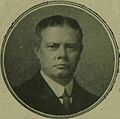| Clapham | |
|---|---|
| Former borough constituency for the House of Commons | |
 Clapham in London 1885-1918 | |
| 1885–February 1974 | |
| Seats | one |
| Created from | East Surrey (one and a half parishes of) |
| Replaced by | Streatham and Lambeth Central |
| During its existence contributed to new seat(s) of | Battersea South |
Clapham was a borough constituency in South London which returned one Member of Parliament (MP) to the House of Commons of the UK Parliament. It was created in time for the 1885 general election then altered in periodic national boundary reviews, principally in 1918, and abolished before the February 1974 general election. In its early years (until 1918) the seat was officially named Battersea and Clapham Parliamentary Borough: No. 2—The Clapham Division.
Contents
- Boundaries
- Members of Parliament
- Election results
- Elections in the 1880s
- Elections in the 1890s
- Elections in the 1900s
- Elections in the 1910s
- Elections in the 1920s
- Elections in the 1930s
- Elections in the 1940s
- Elections in the 1950s
- Elections in the 1960s
- Elections in the 1970s
- References
- Bibliography








